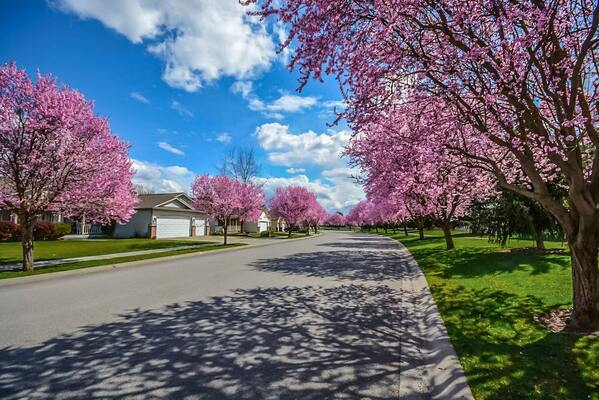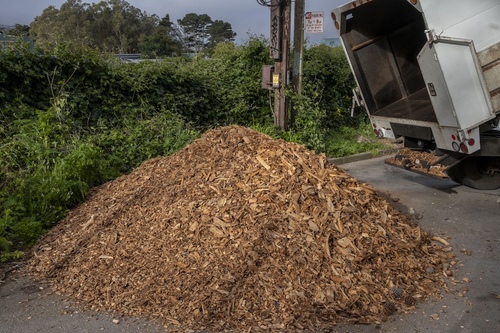Top 5 Tips for Spring Tree Preparation

Top 5 Tips for Spring Tree Preparation
Spring has finally arrived, and it's time to give your trees the care they deserve. Whether you're a new homeowner or a seasoned landscaper, these top five tips will guide you through essential spring tree preparation, ensuring your trees thrive in the months ahead.
Springtime is the perfect time to start providing your trees with some extra love and attention. Since they have been essentially asleep for the past three months, accumulating moisture and debris, it is vital that your trees are taken care of as early into spring as possible.
Cleaning
Cleaning is the foundational step in spring tree preparation, ensuring a healthy environment for optimal tree growth. Over the winter months, trees accumulate debris such as dead leaves, snow, rain, and wildlife activity, creating an environment ripe for pests and diseases. By thoroughly cleaning the tree and its surroundings, you set the stage for successful tree care.
Remove Holiday Decorations
Begin by removing any lingering holiday decorations from the tree trunks and branches. While festive lights may add charm during the holiday season, leaving them up year-round can hinder tree growth. The wires and ties used to secure decorations can constrict growth, warping the tree and causing long-term damage. Safely remove all decorations to allow the tree to thrive uninhibited. Nevertheless, if you want to keep your lights up year-round, there are safe ways to do so as well.
Weed Control
Weeding around the base of the trees is essential for eliminating competition for nutrients and water. Springtime provides an ideal opportunity to tackle weeds before they become established. Take care to remove weeds by the root, ensuring they don't regrow and compete with your trees for resources. A weed-free environment promotes healthy root development and minimizes the risk of disease.
Clear Debris
Rake away dead leaves, sticks, and other debris from the area surrounding the tree. Clearing a three-to-four-foot radius around the base of the tree creates a clean space for mulching and other maintenance tasks. Removing debris not only enhances the aesthetic appeal of your landscape but also reduces the risk of mold, fungus, and pest infestations.
Additional Information: Proper cleaning is the first line of defense against pests, diseases, and environmental stressors. By investing time in thorough cleaning, you create an optimal growing environment for your trees, setting the stage for a season of vibrant growth and vitality.
Mulching
Mulching is a vital step in spring tree preparation, providing numerous benefits for tree health. A layer of mulch around the base of your trees helps retain moisture, suppress weed growth, and protect the soil from temperature fluctuations. Proper mulching techniques not only enhance the aesthetics of your landscape but also support the long-term health of your trees.
A Fresh Mulch Drop
Benefits of Mulching
- Moisture Retention: Mulch acts as a barrier, preventing moisture loss from the soil through evaporation or water runoff. This is particularly beneficial during the warmer spring months when trees require adequate hydration to support new growth.
- Weed Suppression: By blocking sunlight and oxygen from reaching the soil surface, mulch inhibits weed germination and growth. This reduces competition for nutrients and water, allowing your trees to thrive without interference.
- Soil Protection: Mulch provides a protective layer over the soil, shielding it from erosion, compaction, and temperature fluctuations. This insulation helps maintain a stable soil environment, which is crucial for healthy root development.
Mulching Techniques
- Apply a Thick Layer: Spread a layer of mulch around each tree trunk, extending outward to the drip line. Aim for a depth of three to four inches, ensuring uniform coverage without smothering the roots. Avoid piling mulch against the trunk, as this can lead to moisture retention and root rot.
- Choose the Right Material: Organic mulches, such as wood chips, shredded bark, or compost, are ideal for tree mulching. These materials gradually decompose, enriching the soil with organic matter and nutrients. Avoid using plastic mulch or rock mulch, as they can disrupt soil aeration and drainage.
- Maintain Proper Mulch Depth: Over time, mulch may decompose or compact, requiring replenishment. Check the mulch depth regularly and add more as needed to maintain the desired thickness. Be mindful not to exceed the recommended depth, as excessive mulch can create a breeding ground for pests and diseases.
Mulching Tips
- Keep Mulch Away from Trunk: Leave a small gap between the mulch layer and the tree trunk to prevent moisture buildup and discourage pests. This ensures adequate air circulation around the trunk and reduces the risk of fungal infections.
- Refresh Mulch Annually: Reapply mulch annually or as needed to maintain the desired depth and appearance. Springtime is an ideal opportunity to refresh mulch beds, providing an added layer of protection before the growing season begins.
Additional Information: Proper mulching is a simple yet effective way to support tree health and vigor. By incorporating mulching into your spring tree care routine, you provide your trees with the best possible start to the growing season, setting them up for success in the months ahead.
Watering

A Gardener Watering Plants
Watering is a crucial aspect of spring tree care, especially as temperatures rise and soil moisture levels fluctuate. Proper watering ensures that your trees receive the hydration they need to support new growth and withstand environmental stressors. By following watering best practices, you can promote healthy root development and overall tree vitality.
Understanding Watering Needs
- Assess Soil Moisture: Before watering, assess the soil moisture level around your trees. Use a soil moisture meter or simply dig a small hole near the tree's root zone to gauge moisture levels. Ideally, the soil should be evenly moist but not waterlogged.
- Consider Tree Age and Type: The watering needs of trees vary depending on factors such as age, species, and environmental conditions. Younger trees and newly planted specimens require more frequent watering to establish their root systems, while mature trees may require less frequent but deeper watering. With trees that are established and over a few years old, make sure not to water them directly on or next to the trunk. The roots of the tree extend much further than that, and watering them in a wider circle around the trunk will keep it healthier and protected from disease. If you have a younger tree, you'll want to water closer to the trunk.
- Observe Environmental Factors: Factors such as temperature, humidity, and rainfall influence tree watering requirements. During hot and dry periods, trees may require more frequent watering to prevent moisture stress and dehydration.
Proper Watering Techniques
- Water Deeply and Infrequently: Instead of frequent, shallow watering, aim to water trees deeply and infrequently. This encourages deep root growth and helps trees develop resilience to drought conditions. Apply water slowly to allow for deep penetration into the soil. Since tree roots are ideally about 18-24 inches below the surface, it is better for them to get a complete soaking less often to ensure they retain more water.
- Water at the Right Time: The best time to water trees is early in the morning or late in the afternoon. Avoid watering during the hottest part of the day, as this can lead to excessive evaporation and water loss. Watering in the evening may promote fungal diseases by leaving foliage wet overnight.
- Use Drip Irrigation or Soaker Hoses: Drip irrigation systems or soaker hoses deliver water directly to the root zone, minimizing water waste and promoting efficient absorption. These methods also help keep foliage dry, reducing the risk of fungal diseases.
Tailoring Watering Practices
- Adjust for Soil Type: Soil type influences water retention and drainage. Sandy soils drain quickly and may require more frequent watering, while clay soils retain moisture longer. Adjust your watering frequency and duration accordingly based on soil type.
- Monitor Weather Conditions: Keep an eye on weather forecasts and adjust your watering schedule accordingly. Trees may require more frequent watering during periods of hot, dry weather and less during periods of rainfall.
- Observe Tree Response: Pay attention to signs of moisture stress, such as wilting leaves, drooping branches, or dry soil. Adjust your watering practices based on the tree's response to ensure adequate hydration.
Additional Information: Proper watering is essential for tree health and vitality, especially during the spring when trees are actively growing and establishing new foliage. By following these watering guidelines and monitoring your trees' moisture needs, you can ensure they receive the hydration they need to thrive throughout the growing season.
Pruning
Spring Pruning of Fruit Trees - Photo by Blickpixel on Pixabay
Pruning plays a vital role in spring tree care, promoting structural integrity, airflow, and overall health. Springtime provides an ideal window for pruning, as your trees have been dormant for the past few months, making it easier to identify and address issues such as dead or diseased branches. By following proper pruning techniques, you can enhance the appearance and longevity of your trees while reducing the risk of pest infestations and diseases.
Benefits of Spring Pruning
- Deadwood Removal: Removing dead, damaged, or diseased branches improves the tree's appearance and reduces the risk of decay and infection. Deadwood can attract pests and pathogens, compromising the tree's health and structural integrity.
- Improved Air Circulation: Pruning opens up the tree canopy, allowing for better airflow and sunlight penetration. This reduces the risk of fungal diseases and promotes overall tree vigor.
- Shape and Structure: Pruning helps maintain a desirable shape and structure for your trees, preventing overcrowding and reducing the risk of branch breakage during storms or high winds.
Pruning Techniques
- Identify Pruning Targets: Start by identifying the branches that require pruning. Look for dead, damaged, or crossing branches as well as any extra stubs and signs of disease or decay. Focus on removing branches that detract from the tree's overall health and appearance.
- Use Proper Tools: Use sharp, clean pruning tools appropriate for the size of the branches being pruned. Pruning shears are suitable for small branches, while loppers or pruning saws may be necessary for larger branches. Make clean cuts to promote rapid healing and reduce the risk of infection.
- Follow Pruning Guidelines: When pruning, aim to maintain the tree's natural shape and structure. Avoid overpruning, as this can stress the tree and disrupt its growth patterns. Focus on removing problem branches while preserving the overall health and integrity of the tree.
Safety Considerations
- Consider Tree Size and Location: For larger trees or branches located high above the ground, consider hiring a professional arborist to safely perform pruning tasks. Arborists have the skills, equipment, and expertise to safely prune trees of all sizes and species.
- Use Proper Safety Gear: When pruning trees, wear appropriate safety gear, including gloves, eye protection, and sturdy footwear. Exercise caution when working at heights or using power tools to minimize the risk of accidents or injuries.
Post-Pruning Care
- Monitor Tree Health: After pruning, monitor the tree for signs of stress or infection. Keep an eye on the pruning wounds for any signs of decay or discoloration. Proper post-pruning care, including watering and fertilization, can help the tree recover and thrive.
Additional Information: Pruning is a critical aspect of tree maintenance, promoting health, safety, and aesthetics. By following proper pruning techniques and safety guidelines, you can ensure that your trees remain healthy, beautiful, and resilient for years to come. If in doubt, consult with a professional arborist for expert advice and assistance.
Fertilizing
Fertilizing your trees in the spring provides essential nutrients to support vigorous growth and overall health. Springtime is an opportune moment to replenish soil nutrients, giving your trees a nutrient boost as they enter the active growing season. By following proper fertilizing techniques and guidelines, you can ensure that your trees have the resources they need to thrive.
Benefits of Spring Fertilization
- Promotes Growth: Fertilizer provides trees with essential nutrients, including nitrogen, phosphorus, and potassium, which are crucial for healthy growth and development. A well-fertilized tree is better equipped to produce vibrant foliage, robust branches, and abundant blooms.
- Enhances Root Development: Fertilizer stimulates root growth, enabling trees to establish strong and extensive root systems. Healthy roots improve nutrient and water uptake, making trees more resilient to environmental stressors such as drought and disease.
- Boosts Overall Health: Proper fertilization strengthens trees' immune systems, making them more resistant to pests, diseases, and environmental stressors. Well-fed trees are better equipped to withstand adverse conditions and thrive in their surroundings.
Fertilizing Techniques
- Choose the Right Fertilizer: Select a high-quality, balanced fertilizer formulated specifically for trees and shrubs. Look for products labeled for spring application with a balanced ratio of nitrogen, phosphorus, and potassium (NPK). Slow-release or organic fertilizers are preferred for their long-lasting effects and environmental benefits.
- Calculate Application Rates: Determine the appropriate amount of fertilizer based on the size and age of your trees. For larger trees, apply approximately ¼ to ½ pound of nitrogen per inch of trunk diameter. Smaller trees may require less fertilizer, typically around ¼ pound per tree. Over time it will be easier to tell if more fertilizer is needed, but this is a good place to start.
- Apply Fertilizer Correctly: Spread the fertilizer evenly around the drip line of the tree, avoiding direct contact with the trunk. This ensures that the roots receive maximum exposure to the nutrients. For faster absorption, consider using a fertilizer probe or punch to create holes in the soil around the tree.
Timing and Frequency
- Spring Application: Apply fertilizer in early spring, just before the trees enter their active growth phase. This timing allows the trees to absorb and utilize the nutrients efficiently as they begin to put out new growth.
- Monitor Nutrient Levels: Regularly monitor soil nutrient levels and adjust your fertilization schedule as needed. Soil testing can provide valuable insights into the nutrient composition of your soil, helping you tailor your fertilization program to meet your trees' specific needs.
Post-Fertilization Care
- Watering: After applying fertilizer, water the trees thoroughly to help the nutrients penetrate the soil and reach the roots. Adequate watering is essential to activate the fertilizer and promote nutrient uptake by the trees.
- Mulching: Consider adding a layer of mulch around the base of the tree to conserve soil moisture and protect the roots. Mulch also helps prevent nutrient leaching and promotes soil health, complementing the effects of fertilization.
Additional Information: Fertilizing your trees in the spring is a proactive step toward ensuring their health and vitality throughout the growing season. By providing essential nutrients and proper care, you can support robust growth, vibrant foliage, and long-term resilience in your trees. If you're unsure about fertilizing techniques or nutrient requirements, consult with a certified arborist for personalized advice and recommendations.
Conclusion

Suburban Oasis: Victorian Charm Meets Lush Landscaping
In addition to these tips, Arborist Now offers professional tree care services to help you maintain the health and vitality of your trees. Contact us for expert assistance tailored to your tree care needs—we'd be more than happy to help!
Remember, tree care is a year-round commitment. By taking proactive steps in the early spring, you set your trees up for success throughout the year. With these tips and professional support, your trees will thrive and flourish this season and beyond.
Originally posted on May 7, 2018






